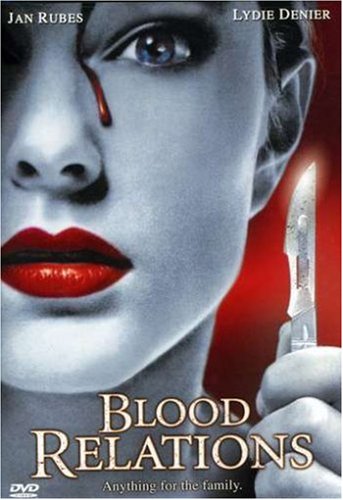|
Blood Relations Film review by Thomas M. Sipos |
|
MENU Books Horror Film Festivals and Awards
Pursuits
Blogs Horror Film Festivals and Awards
Other
|
Blood Relations (1987, dir: Graeme Campbell; cast: Jan Rubes, Lydie Denier, Kevin Hicks, Lynne Adams, Ray Walston)
Marie (Lydie Denier) is the Eurotrash femme fatale, engaged to Thomas (Kevin Hicks), a young expectant heir eager to inherit his grandfather's fortune. Granddad (everyone's favorite Martian, Ray Walston) is already dying, so all Thomas and Marie need do is kill Thomas's dad (Jan Rubes) to assure Thomas is the sole heir. Thomas brings Marie home to meet the family: just dad and granddad. All three generations of men take a liking to Marie, who resembles Thomas's dead mother (Rubes's dead wife, Walston's dead daughter). Things get kinky. Granddad asks Marie to call him "father." Then he asks her to strip naked and kiss him. So she does. Hey, he's worth a fortune, right? Blood Relations threads noir terrain, so there's the requisite shyster lawyer to draft the will, his faithless wife (girlfriend?), and a creepy servant. No one is to be trusted, everyone plots against everyone else, forming shifting alliances over who might inherit the dying granddad's estate. There are faked deaths, lies and betrayals, and a dead cat. Dad romances both his lawyer's wife and Marie, bedding one and telling the other that his son "is not a real man" and will inherit nothing. Blood Relations's milieu resembles that of The Shining and Curtains. All three films feature small casts wandering within vast snowbound mansions. Yet while The Shining and Curtains are enhanced by their stark wintry milieu, Blood Relations is diminished. Shorn of padding and distractions, the former two films reveal compelling stories, gripping emotional subtexts, and strong casts; Blood Relations is left with nothing but a banal hackneyed script, performed by competent but unspectacular actors. Despite its lavish mansion set (the only location aside from a few hospital rooms), Blood Relations feels surprisingly cheap. Just a handful of characters wandering spacious halls. It doesn't feel spooky or claustrophobic (as does The Haunting). It only feels empty and low-budget and ... cheap. Only one servant in sight. It's not until the film's final third that the suspense/noir elements are discarded for horror. I don't want to spoil too many surprises. Just know that dad is a brain surgeon. In a horror film, that means he likes to transplant brains, whether the subject is willing or not. And serendipitously for horror fans, brain surgery is often best conducted while the subject is conscious.
Blood Relations isn't the first, nor last, film to feature consciously aware brain torture. Bloodsucking Freaks (1977) and Hannibal both come to mind. Happily, despite its tepid noir elements, when Blood Relations (finally) shifts into horror, it manages some disturbing and effective scenes. Not many, but they're there. Also some artily shot "dream" sequences. The ending confuses. I'm not sure where all the brains went. One was cooked, one was transplanted, but what of the rest? If you enjoy hackneyed low-budget noir, perhaps you won't mind waiting to get to the gory horror. Poor Marie. All that noir buildup, then the rules change. For while femme fatales often triumph in noir, horror is a mad scientists' genre. Review copyright by Thomas M. Sipos
|
"Communist Vampires" and "CommunistVampires.com" trademarks are currently unregistered, but pending registration upon need for protection against improper use. The idea of marketing these terms as a commodity is a protected idea under the Lanham Act. 15 U.S.C. s 1114(1) (1994) (defining a trademark infringement claim when the plaintiff has a registered mark); 15 U.S.C. s 1125(a) (1994) (defining an action for unfair competition in the context of trademark infringement when the plaintiff holds an unregistered mark).


